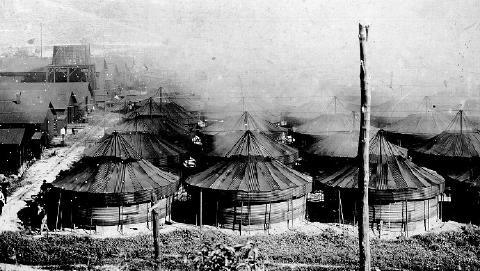CALHOUN ONCE HAD WORLD'S LARGEST CARBON BLACK FACTORY

Cabot's carbon black plant, once the world's largest, running
full throttle in early 1900s. (Photo courtesy of Harold Ferrell)
By Dave Tabler
www.appalachianhistory.net
"In this county Godfrey L. Cabot of Boston, MA has the largest carbon factory in the world, utilizing natural gas for the purpose," stated the WV Geological Survey about Calhoun County in 1911.
"The product is wagoned to Creston where it is loaded on boats and shipped down the Little Kanawha River to railway connection at Owensport, the southern terminus of the Little Kanawha Railroad. Mr. Cabot has another factory located at Creston in Wirt County."
The most widely used black pigment, carbon black is virtually pure carbon, made from the incomplete combustion of petrochemical oils of gases. It is widely used even today as a filler in the rubber industry and as a UV stabilizer in plastics.
Distinct from soot, this substance, sometimes called lamp black, has been around for a long time. Prehistoric cave dwellers used it to draw animals on cave walls, and the Egyptian pharaohs used it as a pigment. Cabot and his brother Samuel saw similar applications for it.
The Cabot brothers didn't begin their business in West Virginia. They first built a plant in Buffalo Mills, PA, that used natural gas to produce carbon black in 1882, and in 1884 Godfrey patented a carbon black production process that used stationary plates and rotating burners. In 1887 Godfrey bought out Samuel's interest in the business.
At about this time, a glut developed in the carbon black market; at the same time, new uses were being found for natural gas, which was the raw material for carbon black. Cabot's response was to purchase gas leases and drill on the sites, drilling his first successful gas well in Saxonburg, PA, in 1888.
He continued, despite the glut, to buy up small carbon black factories as well, and by 1897 he was probably the largest producer in the industry.
In 1898, with the exhaustion of the Pennsylvania gas fields, Cabot moved his operation to West Virginia, where he acquired oil and gas leases, which he drilled successfully.
By 1900 the new carbon factory - Cabot Station, in Grantsville employed twelve men paid from $1.25 to $2 a day. The plant was producing 800 pounds of carbon black a day when it first opened, but that quickly increased to 1,400 pounds. Cabot continued to add gas sites in West Virginia, and built a natural gasoline extraction plant near Creston, West Virginia, in 1914.
While the advent and spread of high-speed presses and similar applications greatly expanded Cabot's business, World War I demonstrated the potential for carbon black in the modern economy.
It had been known for a while that carbon black could inhibit damage to materials caused by the sun; a few years before that war, the India Rubber Gutta-Percha and Telegraph Works Co. of Silvertown, England, began to manufacture automobile tires using carbon black as a stabilizing or reinforcing agent.
During World War I the United States began using carbon black, and its superior properties became evident in improved tread wear and lower rates of tire failure. After the war, its use spread throughout the tire industry, providing a tremendous burst of growth to suppliers.
By the early 1920s, Cabot's carbon black production was shifted out of West Virginia, first, unsuccessfully, to Louisiana, and then to Texas.
Meantime Cabot's original factory in Grantsville - Cabot Station - was shifted to a compressor or pump station for natural gas by the Hope Natural Gas Company, which had purchased the property.
Today the spot of the former world's largest carbon factory in Calhoun County, WV is home to Cabot Recycling Center.
Sources:
- www.hurherald.com
- West Virginia Geological Survey: Wirt, Roane and Calhoun Counties, by Ray Vernon Hennen, W. J. Latimer, F. N. Meeker, 1911, Acme Publishing Co.
See related stories with photos BOSTON-ON-KANAWHA - Cabot Station's 100 Years, World's Biggest Carbon Black Factory
LUM SHAFFER NOW IN ETERNITY - Saturated With Paraffin, "Burned To A Crisp" In Cabot Station Fire
BLINDING FLASH, DEAFENING CONCUSSION AND DEATH - Thanksgiving Tragedy 1945: Cabot Station Explodes